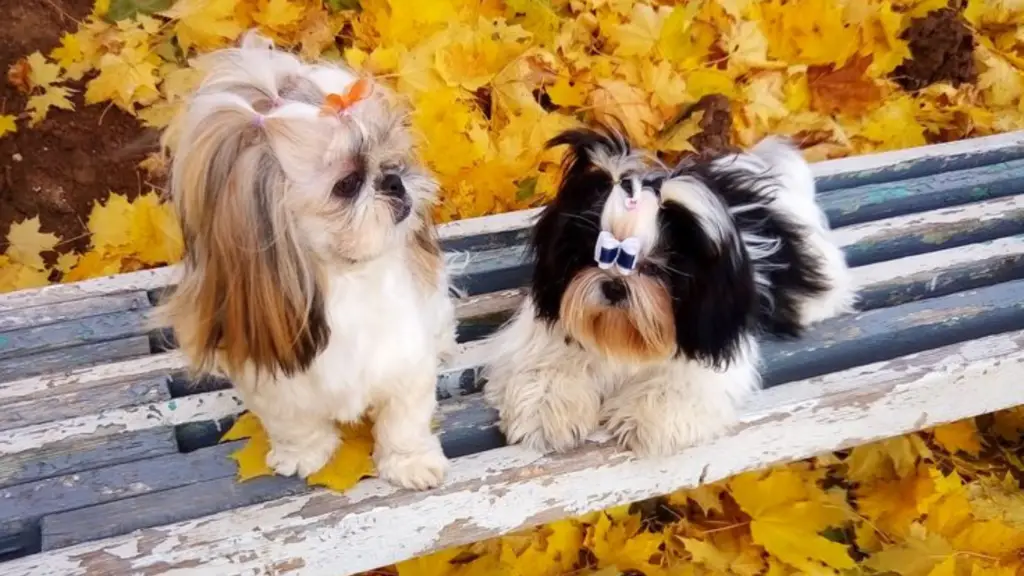
Taking care of your Shih Tzu’s paws is an essential aspect of maintaining their overall health and well-being. Their paws are not only vital for movement but also serve as sensitive indicators of their environment. Regular paw care can prevent potential issues, such as infections, injuries, and discomfort. This guide will explore everything you need to know about Shih Tzu paw care, including cleaning, trimming, protecting, and preventing common paw problems.
The Importance of Regular Paw Care for Shih Tzus
Why Paw Care Matters
Paw care is crucial for Shih Tzus because their paws are constantly exposed to various surfaces, temperatures, and potential hazards. Their paws are responsible for supporting their entire body weight, and any discomfort or injury can significantly impact their mobility and quality of life. Regular paw care helps to keep their feet healthy, prevents common issues like cracked pads or infections, and ensures that your Shih Tzu remains active and comfortable.

Understanding the Structure of a Shih Tzu’s Paw
A Shih Tzu’s paw consists of several components, including pads, nails, and fur. The pads act as shock absorbers, providing cushioning and protection against rough surfaces. The nails offer grip and stability, while the fur helps insulate the paws from extreme temperatures. Each of these components requires proper care to function effectively. Neglecting any part of the paw can lead to discomfort and potential health issues for your Shih Tzu.
Common Paw Problems in Shih Tzus
Shih Tzus are prone to several paw-related problems, including cracked pads, overgrown nails, and infections. Cracked pads can result from exposure to harsh surfaces or extreme weather conditions, leading to pain and discomfort. Overgrown nails can affect your Shih Tzu’s gait and cause discomfort, while infections can arise from cuts, foreign objects, or inadequate cleaning. Understanding these common problems is the first step in preventing them and keeping your Shih Tzu’s paws healthy.

Signs of Paw Discomfort in Shih Tzus
It’s essential to recognize the signs of paw discomfort in your Shih Tzu. These signs may include limping, licking or chewing at their paws, redness or swelling, and reluctance to walk or play. If you notice any of these symptoms, it’s crucial to inspect your Shih Tzu’s paws for any visible issues and seek veterinary advice if necessary. Early detection and intervention can prevent minor issues from becoming more serious problems.
The Role of Paw Care in Your Shih Tzu’s Overall Health
Paw care is not just about maintaining healthy feet; it also plays a significant role in your Shih Tzu’s overall health. Healthy paws contribute to better mobility, comfort, and the ability to engage in physical activities. Moreover, regular paw inspections allow you to detect other health issues early, such as skin conditions, allergies, or infections. By prioritizing paw care, you are ensuring that your Shih Tzu remains healthy, happy, and active.

Proper Cleaning Techniques for Shih Tzu Paws
Why Regular Cleaning is Essential
Regular cleaning of your Shih Tzu’s paws is essential to remove dirt, debris, and potential irritants that can accumulate between their pads and toes. This is particularly important after walks or outdoor play, as their paws can pick up various contaminants from the ground. Keeping their paws clean reduces the risk of infections and prevents discomfort caused by trapped debris. Regular cleaning also allows you to inspect their paws for any cuts, wounds, or foreign objects.
Step-by-Step Guide to Cleaning Your Shih Tzu’s Paws

- Gather Your Supplies: You will need a bowl of warm water, a mild dog shampoo, a soft cloth or sponge, and a towel. Optional items include paw wipes and a paw balm for moisturizing.
- Inspect the Paws: Before cleaning, inspect each paw for any visible issues, such as cuts, cracks, or foreign objects. Pay close attention to the areas between the toes and pads.
- Soak the Paws: Dip your Shih Tzu’s paw into the bowl of warm water. If they are uncomfortable with soaking, you can use a damp cloth to wipe their paws.
- Clean the Paws: Apply a small amount of dog shampoo to the cloth or sponge and gently clean the pads, toes, and nails. Be sure to clean between the toes to remove any trapped debris.
- Rinse and Dry: Thoroughly rinse the paws with clean water to remove any shampoo residue. Dry each paw with a towel, ensuring they are completely dry to prevent moisture-related issues.
- Apply Paw Balm (Optional): If your Shih Tzu’s pads are dry or cracked, apply a paw balm to moisturize and protect them.
Using Paw Wipes for Quick Cleaning
Paw wipes are a convenient option for quick cleaning when you’re short on time or after a short walk. These pre-moistened wipes are designed to clean and disinfect your Shih Tzu’s paws, removing dirt and bacteria effectively. They are especially useful for cleaning between the toes and pads. While paw wipes are convenient, they should not replace regular, thorough cleaning but can be used in between more comprehensive cleanings.

When to Use Paw Soaks
Paw soaks can be particularly beneficial for Shih Tzus with sensitive or irritated paws. A paw soak involves immersing your dog’s paws in a solution of warm water and a mild antiseptic or soothing ingredient like Epsom salts or chamomile. Paw soaks can help soothe irritated skin, reduce inflammation, and remove deep-seated dirt or allergens. They are especially useful after exposure to harsh chemicals, such as road salt, or during allergy season.
Avoiding Harsh Chemicals
When cleaning your Shih Tzu’s paws, it’s crucial to avoid harsh chemicals or human soaps, as they can irritate your dog’s sensitive skin. Always use a mild dog-specific shampoo or a veterinarian-recommended product. If you need to clean their paws after exposure to potentially harmful substances like road salt, ensure you rinse their paws thoroughly with clean water to remove any residues.
Routine Inspection and Maintenance

Incorporate paw cleaning into your Shih Tzu’s regular grooming routine. Aim to clean their paws after every walk, especially if they’ve been in muddy or dirty areas. Regular cleaning not only keeps their paws healthy but also allows you to monitor for any signs of potential issues, ensuring early detection and treatment.
Trimming Your Shih Tzu’s Nails for Optimal Paw Health
Why Nail Trimming is Important
Nail trimming is a vital aspect of paw care that should not be overlooked. Overgrown nails can cause discomfort, affect your Shih Tzu’s gait, and even lead to more serious issues, such as ingrown nails or joint problems. Regular nail trimming helps maintain the proper length of the nails, preventing them from becoming too long and causing pain or difficulty walking. It also reduces the risk of nails breaking or splitting, which can be painful and lead to infections.

Identifying the Right Nail Length
The ideal nail length for a Shih Tzu is when the nails do not touch the ground while the dog is standing. If you hear clicking sounds when your Shih Tzu walks on hard surfaces, it’s a sign that the nails are too long and need to be trimmed. Proper nail length ensures that your Shih Tzu can walk comfortably and maintain proper posture, reducing the risk of strain on their joints and muscles.
Tools You’ll Need for Nail Trimming
To trim your Shih Tzu’s nails, you’ll need the right tools, including a pair of dog nail clippers or a nail grinder, styptic powder (in case of accidental cuts), and a treat for rewarding your dog afterward. Dog nail clippers come in various styles, such as guillotine, scissor, and plier types, while nail grinders offer a more gradual and less intimidating way to shorten nails. Choose the tool that you and your Shih Tzu are most comfortable with.

Step-by-Step Guide to Trimming Your Shih Tzu’s Nails
- Prepare Your Dog: Before you start, make sure your Shih Tzu is calm and relaxed. Offer them a treat or some gentle petting to put them at ease.
- Hold the Paw Gently: Hold your Shih Tzu’s paw firmly but gently, ensuring you have a clear view of the nail.
- Identify the Quick: The quick is the pinkish area inside the nail that contains blood vessels and nerves. Avoid cutting into the quick, as it can cause pain and bleeding. On white nails, the quick is visible, but on black nails, it may be more challenging to identify, so trim small amounts gradually.
- Trim the Nail: Position the clippers or grinder at a 45-degree angle and trim a small portion of the nail at a time. If using clippers, make sure to make quick, clean cuts to avoid splitting the nail.
- Check Each Nail: After trimming one nail, check the length and ensure you’re not too close to the quick before moving on to the next nail.
- Reward Your Dog: After trimming all the nails, reward your Shih Tzu with a treat and praise for their cooperation.
Using a Nail Grinder for Sensitive Dogs
If your Shih Tzu is sensitive to nail clippers, a nail grinder may be a better option. Nail grinders use a rotating file to gradually shorten the nails, which can be less stressful for some dogs. The process is slower but allows for more precision, reducing the risk of cutting the quick. Introduce the grinder slowly, letting your Shih Tzu get used to the sound and sensation before starting the trimming process.

Frequency of Nail Trimming
How often you need to trim your Shih Tzu’s nails depends on their lifestyle and activity level. Generally, nail trimming should be done every 3-4 weeks, but more active dogs that walk on hard surfaces may need less frequent trims. Regular trimming keeps the nails at a healthy length and prevents them from growing too long and causing discomfort.
Dealing with Accidents and Bleeding
Accidents can happen during nail trimming, especially if you accidentally cut the quick. If this occurs, apply styptic powder to the bleeding nail to stop the bleeding. It’s important to stay calm and reassure your Shih Tzu during this time. If you’re unsure about trimming your dog’s nails yourself, consider seeking help from a professional groomer or veterinarian.
Protecting Your Shih Tzu’s Paws from Environmental Hazards

The Impact of Hot Pavement on Paws
Hot pavement can be extremely harmful to your Shih Tzu’s paws, causing burns and discomfort. During the summer months, pavement and asphalt can reach temperatures high enough to cause serious injury. Before taking your Shih Tzu for a walk, check the pavement’s temperature by placing your hand on it for a few seconds. If it’s too hot for your hand, it’s too hot for your dog’s paws. To protect your Shih Tzu from hot pavement, consider walking them early in the morning or late in the evening when the temperatures are cooler.
Cold Weather Concerns and Paw Protection
Cold weather presents its own set of challenges for your Shih Tzu’s paws. Ice, snow, and road salt can all cause irritation, dryness, and even frostbite. To protect your dog’s paws during the winter, consider using dog booties or applying a protective paw balm before heading outside. After walks, clean your Shih Tzu’s paws thoroughly to remove any salt or ice that may have become trapped between their toes. Regular moisturizing with a paw balm can help prevent dryness and cracking during the colder months.

Using Paw Balms and Waxes
Paw balms and waxes are excellent products for protecting your Shih Tzu’s paws from harsh environmental conditions. These products create a barrier that shields the paws from hot pavement, cold weather, and rough terrain. When choosing a paw balm or wax, look for one that is specifically designed for dogs and free from harmful chemicals. Apply the balm before walks or outdoor activities, and reapply as needed. Regular use of paw balms can also help keep your Shih Tzu’s pads soft and supple, preventing cracks and dryness.
Avoiding Chemical Exposure
Chemical exposure is another concern for your Shih Tzu’s paws. Lawn treatments, pesticides, and road salt can all cause irritation and discomfort. After walks, especially in areas where chemicals may have been used, thoroughly clean your Shih Tzu’s paws to remove any residues. Avoid walking your dog in areas that have been recently treated with chemicals, and consider using protective booties if exposure is unavoidable.

Dealing with Allergens
Shih Tzus, like many dogs, can be sensitive to environmental allergens such as pollen, grass, and mold. These allergens can cause itching, redness, and discomfort in their paws. Regular paw cleaning can help remove allergens and reduce irritation. If your Shih Tzu is particularly sensitive, consider using hypoallergenic wipes or a specialized paw wash to minimize exposure to allergens. Consult your veterinarian if you notice persistent paw licking, redness, or swelling, as these may be signs of an allergic reaction.
The Benefits of Booties for Paw Protection
Dog booties are an excellent option for protecting your Shih Tzu’s paws from environmental hazards. They provide a barrier against hot pavement, cold weather, and rough terrain, reducing the risk of injury and discomfort. Booties can also prevent your dog from coming into contact with harmful chemicals or allergens. When choosing booties, make sure they fit properly and are comfortable for your Shih Tzu to wear. Start with short, supervised sessions to help your dog get used to wearing them.

Creating a Safe Environment at Home
In addition to outdoor hazards, it’s important to ensure that your home environment is safe for your Shih Tzu’s paws. Keep floors clean and free from sharp objects that could cause injury. Regularly check your yard for any potential hazards, such as sharp rocks, thorns, or broken glass. By creating a safe environment both indoors and outdoors, you can help prevent injuries and keep your Shih Tzu’s paws healthy and comfortable.
Common Paw Issues in Shih Tzus and How to Address Them
Cracked Pads and Dryness
Cracked pads are a common issue in Shih Tzus, often caused by exposure to harsh surfaces, extreme temperatures, or lack of moisture. Dry, cracked pads can be painful and may lead to further complications, such as infections. To treat cracked pads, apply a moisturizing paw balm regularly and avoid exposing your dog to rough or hot surfaces. If the cracks are severe or not healing, consult your veterinarian for further treatment options.

Ingrown Nails
Ingrown nails occur when a nail grows into the paw pad or surrounding skin, causing pain, inflammation, and potential infection. This issue is often caused by nails that are too long or improperly trimmed. To prevent ingrown nails, ensure that you trim your Shih Tzu’s nails regularly and avoid cutting them too short. If you notice signs of an ingrown nail, such as swelling, redness, or limping, seek veterinary care promptly to prevent further complications.
Paw Infections
Paw infections can result from cuts, foreign objects, or bacteria entering the paw through a crack or wound. Signs of a paw infection include swelling, redness, pus, and a foul odor. If you suspect your Shih Tzu has a paw infection, it’s important to seek veterinary care immediately. Treatment may include antibiotics, antiseptic soaks, and keeping the paw clean and dry until it heals. Regular paw inspections and prompt treatment of any injuries can help prevent infections from developing.

Interdigital Cysts
Interdigital cysts are painful, fluid-filled lumps that form between a dog’s toes. They are often caused by ingrown hairs, foreign objects, or chronic inflammation. These cysts can cause discomfort and may lead to limping or reluctance to walk. If your Shih Tzu develops an interdigital cyst, consult your veterinarian for treatment options, which may include draining the cyst, antibiotics, or surgical removal in severe cases.
Allergic Reactions
Allergic reactions can manifest in your Shih Tzu’s paws as redness, swelling, and itching. Common allergens include pollen, grass, mold, and certain cleaning products. To address allergic reactions, clean your dog’s paws regularly to remove allergens and consider using hypoallergenic products. If your Shih Tzu continues to experience allergic symptoms, consult your veterinarian for advice on managing their allergies, which may include medications or dietary changes.
Cuts and Wounds

Cuts and wounds on your Shih Tzu’s paws can occur from sharp objects, rough surfaces, or accidents. These injuries can be painful and may lead to infections if not properly treated. To address cuts and wounds, clean the affected area with an antiseptic solution and apply a sterile bandage if necessary. Monitor the wound for signs of infection, such as redness, swelling, or discharge, and seek veterinary care if the wound does not heal or shows signs of infection.
Burns and Frostbite
Burns and frostbite are severe conditions that can affect your Shih Tzu’s paws if they are exposed to extreme temperatures. Burns may occur from walking on hot pavement, while frostbite can result from exposure to cold weather or ice. Both conditions require immediate veterinary care. To prevent burns and frostbite, avoid walking your dog on hot or icy surfaces, and use protective measures such as booties or paw balms to shield their paws from temperature extremes.
Preventive Measures for Long-Term Paw Health
Regular Paw Inspections
Regular paw inspections are a key preventive measure for maintaining your Shih Tzu’s paw health. By checking their paws frequently, you can identify potential issues early, such as cuts, cracks, or signs of infection. Inspect all parts of the paw, including the pads, nails, and areas between the toes. Look for any abnormalities, such as swelling, redness, or foreign objects, and address them promptly to prevent further complications.
Moisturizing and Hydration

Keeping your Shih Tzu’s paws moisturized is essential for preventing dryness and cracks. Regularly applying a paw balm or moisturizer designed for dogs can help maintain the softness and elasticity of their pads. Additionally, ensuring your dog stays hydrated by providing fresh water at all times supports overall skin and paw health. Hydrated skin is less prone to cracking and irritation, making it an important aspect of paw care.
Balanced Diet for Healthy Paws
A balanced diet plays a significant role in maintaining your Shih Tzu’s overall health, including their paws. Nutrients such as omega-3 fatty acids, vitamins, and minerals contribute to healthy skin and coat, which in turn supports paw health. Providing your Shih Tzu with a high-quality diet that meets their nutritional needs can help prevent issues such as dryness, cracking, and infections. Consult your veterinarian for dietary recommendations tailored to your dog’s specific needs.
Regular Exercise and Safe Surfaces

Regular exercise is important for your Shih Tzu’s physical and mental well-being, but it’s equally important to ensure that they exercise on safe surfaces. Avoid walking your dog on hot pavement, sharp gravel, or rough terrain that could damage their paws. Instead, opt for grassy areas, dirt paths, or other soft surfaces that are gentle on their feet. Providing your dog with regular exercise in a safe environment helps keep their paws healthy and strong.
Protective Measures for Extreme Weather
Extreme weather conditions can pose a significant risk to your Shih Tzu’s paws. In hot weather, avoid walking your dog during the hottest parts of the day, and provide paw protection with booties or balms. In cold weather, use protective booties to prevent frostbite and apply paw balm to keep their pads moisturized. By taking these precautions, you can protect your Shih Tzu’s paws from temperature-related injuries and discomfort.
Training Your Shih Tzu to Tolerate Paw Care

Training your Shih Tzu to tolerate paw care is an essential step in maintaining their long-term paw health. Start by gently handling your dog’s paws from a young age, rewarding them with treats and praise for staying calm. Gradually introduce grooming tools, such as nail clippers or grinders, and allow your dog to become familiar with them before using them. Consistent, positive reinforcement will help your Shih Tzu associate paw care with positive experiences, making the process easier and less stressful for both of you.
Conclusion
Proper paw care is a fundamental aspect of maintaining your Shih Tzu’s overall health and well-being. By regularly inspecting, cleaning, and protecting their paws, you can prevent common issues such as dryness, cracks, infections, and injuries. Additionally, taking preventive measures like regular nail trimming, moisturizing, and providing a balanced diet will contribute to the long-term health of your Shih Tzu’s feet. Remember that environmental factors, such as extreme weather and exposure to chemicals, can also impact your dog’s paw health, so it’s important to take appropriate precautions. By following the tips and strategies outlined in this guide, you can ensure that your Shih Tzu’s paws remain healthy, comfortable, and ready for all the adventures you have together.


